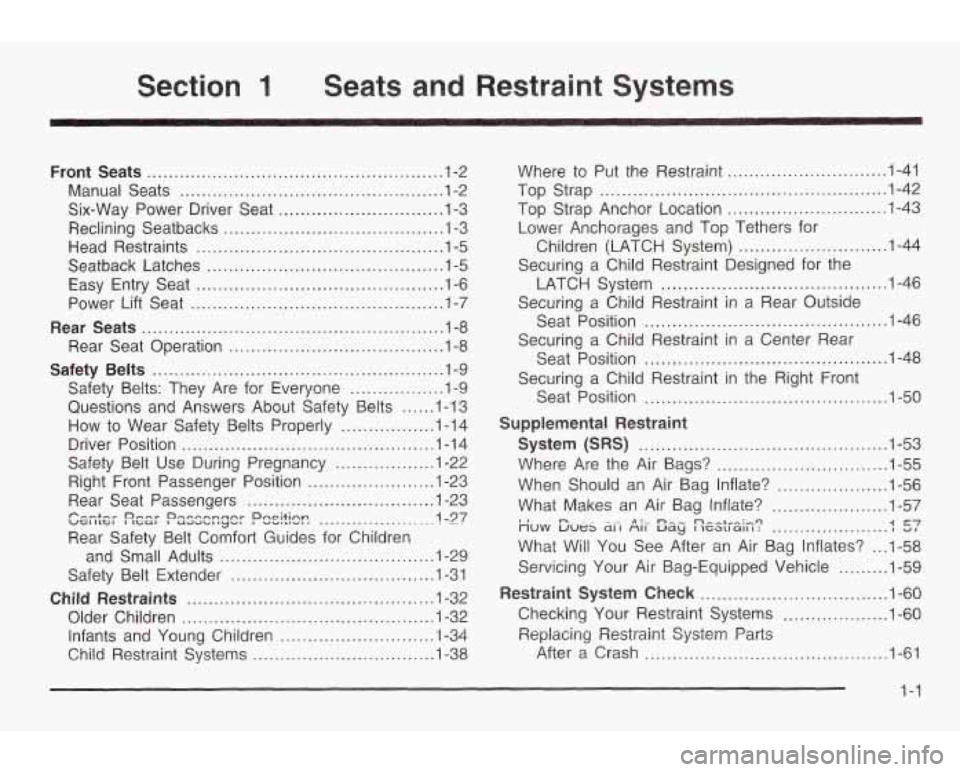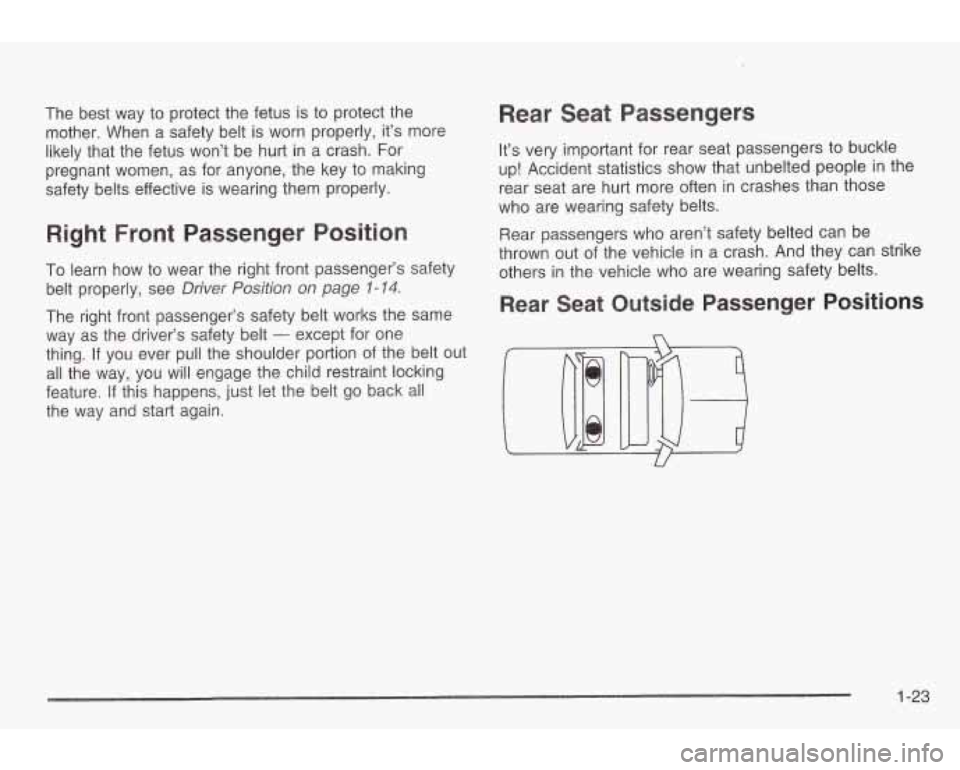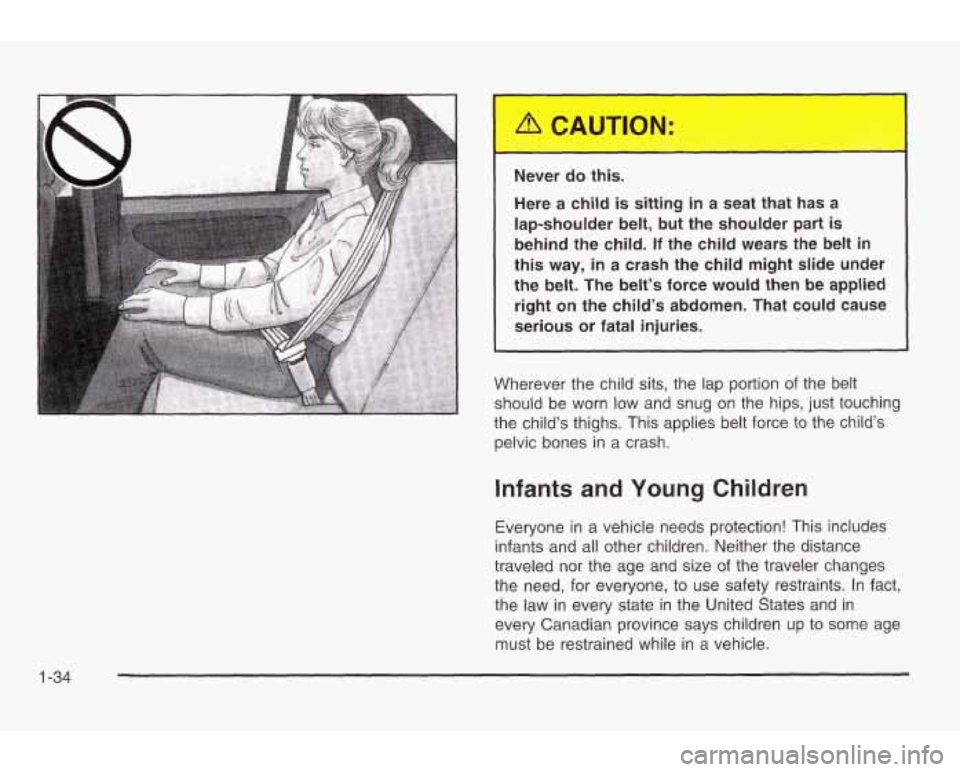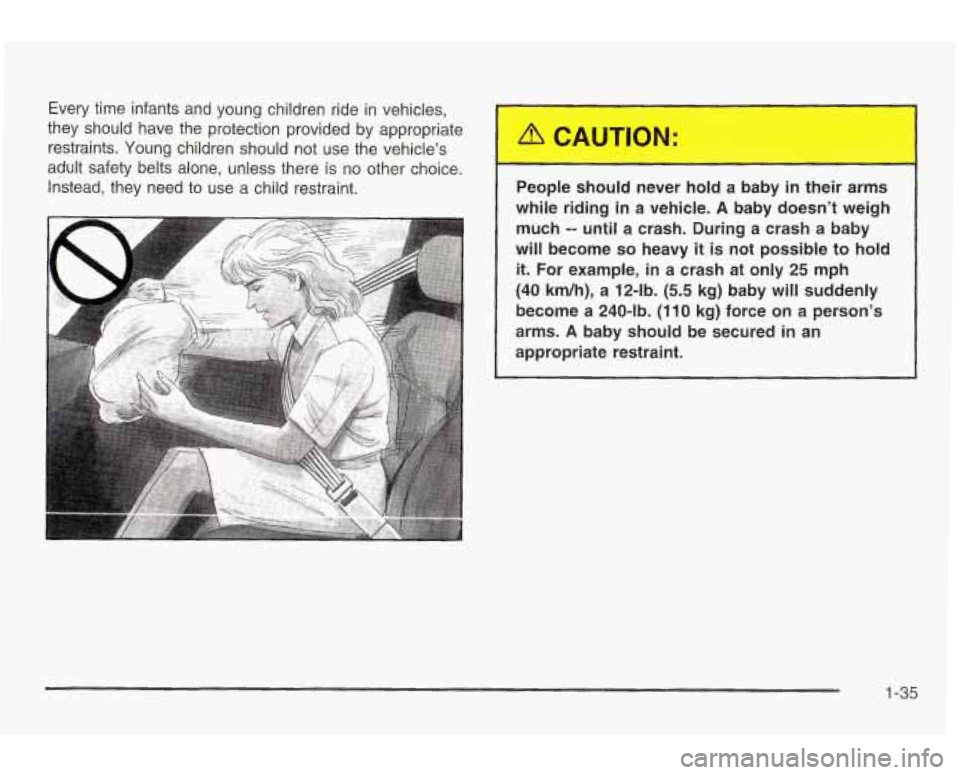child restraint PONTIAC GRAND AM 2003 Owners Manual
[x] Cancel search | Manufacturer: PONTIAC, Model Year: 2003, Model line: GRAND AM, Model: PONTIAC GRAND AM 2003Pages: 354, PDF Size: 16.3 MB
Page 2 of 354

The 2003 Pontiac Grand Am Owner Manual
Seats and Restraint Systems ........................... 1-1
Front Seats ............................................... 1-2
Rear Seats ............................................... 1-8
Safety Belts .............................................. 1-9
Child Restraints ....................................... 1-32
Supplemental Restraint
System
(SRS) ...................................... 1-53
Restraint System Check ............................ 1-60
Keys ........................................................ 2-2
Doors and Locks ....................................... 2-7
Theft-Deterrent Systems ............................ 2-1 7
Starting and Operating Your Vehicle ........... 2-18
Mirrors .................................................... 2-35
Sunroof .................................................. 2-38
Instrument Panel Overview .......................... 3-2
Climate Controls ...................................... 3-1 8
\Warning Lights, Gages a.nd Indicators ......... 3-22
Audio System@) ....................................... 3-38
Features and Controls ..................................... 2-1
Windows ................................................. 2-1 5
Stcr3.g~ .A rean ~ ................... 2-37 ..........
Instrument Panel ............................................. 3-1
Driving Your Vehicle ....................................... 4-1
Your Driving, the Road, and Your Vehicle ..... 4-2
Towing ................................................... 4-32
Service ..................................................... 5-3
Fuel ......................................................... 5-5
Checking Things Under
Service
and Appearance
Care .......................... 5-1
the Hood ............................................. 5-10
Bulb Replacement .................................... 5-49
Windshield Wiper Blade Replacement ......... 5-52
Tires ...................................................... 5-53
Appearance Care ..................................... 5-72
Vehicle Identification ................................. 5-80
Electrical System ...................................... 5-81
Capacities and Specifications ..................... 5-86
Normai iviainienance Fiepiawl I 1t.1-1; F&iJiS ...... 5-00 nn
Maintenance Schedule ..................................... 6-1
bhintenance Schedule ................................ 6-2
Customer Assistance Information .................... 7-1
Customer Assistance Information .................. 7-2
Index ............................................................... ..I
Page 6 of 354

These are some examples of vehicle symbols you may find on your vehicle:
POSSIBLE A
CAUTION
INJURY
PROTECT EYES BY
SHIELDING
CAUSTIC
BATTERY
4CID COULD CAUSE
BURNS
AVOID
SPARKS
OR
FLAMES
SPARK
OR
FLAME 'lb'
COULD
EXPLODE
-
BATTERY
1
I
LATCH BOTH LAP AND
SHOULDER BELTS TO
PROTECT OCCUPANT
4
DO NOT TWIST SAFETY
BELT WHEN ATTACHING
FASTEN SEAT
BELTS
MOVE SEAT FULLY
\!&
REARWARD+ /z
SECURE
CHILD SEAT
PULL BELT
COMPLETELY
-HEN SECURE
CHILD SEAT
?"!"!E?
WINDOW DO
NOT INSTALL
A REAR-FACING
CHILD RESTRAINT IN THIS SEATING
POSITION
DO NOT INSTALL A
FORWARD-FACING CHILD RESTRAINT IN THIS SEATING POSITION
DOOR LOCK UNLOCK LIGHTING
-
PARKING PC
LAMPS
FOG n LAMPS w
ENGINE
COOLANT TEMP
CHARGING
1-1
BAlTERY SYSTEM
COOLANT
a
ENGINE OIL
PRESSURE
Wb
ANTI-LOCK fm)
BRAKES \u/
FJ
ACCESS
ENGINE
COOLANT FAN
FUEL
OWNER'S MANUAL
SERVICE
SERVICE
iviAi\iuWi
V
Page 8 of 354

Section 1 Seats and Restraint Sy
Front Seats ...................................................... 1.2
Manual Seats
................................................ 1.2
Reclining Seatbacks 1 -;j
Head Restraints ............................................. 1.5
Seatback Latches ........................................... 1-5
Easy Entry Seat ............................................. 1-6
Power Lift Seat
.............................................. 1-7
Rear Seats ....................................................... 1-8
Rear Seat Operation
....................................... 1.8
Safety Belts
..................................................... 1.9
Safety Belts: They Are for Everyone ................. 1-9
Questions and Answers About Safety Belts ...... 1-1 3
How
to Wear Safety Belts Properly ................. 1-14
Driver Position
.............................................. 1-1 4
Safety Belt Use During Pregnancy
.................. 1-22
Right Front Passenger Position ....................... 1-23
Rear Seat Passengers
.................................. 1.23
UGI 11G1 I IbUI I U~~~OILJUI VVI.~V. ...................... 1-27
Rear Safety Belt Comfort Guides for Children
and Small Adults
....................................... 1-29
Safety Belt Extender
..................................... 1-31
Child Restraints ............................................. 1.32
Older Children
.............................................. 1-32
Infants and Young Children
............................ 1-34
Child Restraint Systems ................................. 1-38
Six-Way Power Driver Seat
.............................. 1-3 ,-. ........................................
p-- +-v 0n-v Dnemnnnnr Dneitinn
Where to Put
the Restraint ............................. 1-41
Top Strap
.................................................... 1-42
Top Strap Anchor Location
............................. 1.43
Lower Anchorages and Top Tethers for
Children (LATCH System)
........................... 1 -44
Securing a Child Restraint Designed for the
LATCH System
......................................... 1-46
Securing a Child Restraint in a Rear Outside
Seat Position
............................................ 1-46
Securing a Child Restraint in a Center Rear
Seat Position
............................................ 1-48
Securing a Child Restraint in the Right Front
Seat Position
............................................ 1-50
System (SRS) ............................................. 1-53
When Should an Air Bag Inflate?
.................... 1-56
What Makes
an Air Bag Inflate? ..................... 1-57
What Will You See After an Air Bag Inflates? ... 1-58
Servicing Your Air Bag-Equipped Vehicle
......... 1-59
Restraint System Check
.................................. 1-60
Checking Your Restraint Systems
................... 1-60
Repiacing Resirzlint System Parts
After a Crash ............................................ 1-61
Supplemental Restraint
Where Are the Air Bags?
............................... 1-55
nuw Lues 5i-l Ail- Ea9 ECS~E~G? ..................... 157’
1-1
Page 21 of 354

Q: If I’m a good driver, and I never drive far from
home, why should
I wear safety belts?
A: You may be an excellent driver, but if you’re in an
accident
- even one that isn’t your fault - you and
your passengers can be hurt. Being
a good
driver doesn’t protect you from things beyond your
control, such as bad drivers.
Most accidents occur within 25 miles (40 km)
of home. And the greatest number of serious
injuries and deaths occur at speeds of less than
40 mph (65 km/h).
Safety belts are for everyone.
How to Wear Safety Belts Properly
This part is only for people of adult size.
Be aware that there are special things
to know about
safety belts and children. And there are different
rules for smaller children and babies.
If a child will be
riding in your vehicle, see
Older Children on page 1-32
or lnfants and Young Children on page 1-34. Follow
those rules for everyone’s protection. First,
you’ll want
to know which restraint systems your
vehicle has.
We’ll start with the driver position.
Driver Position
This part describes the driver’s restraint system.
Lap-Shsulder Belt
The driver has a lap-shoulder belt. Here’s how to wear it
properly.
1. Close and lock the door.
2. Adjust the seat so you can sit up straight. To see
how, see
Manual Seats on page 1-2 or Six-Way
Power Driver Seat on page 1-3.
1-14
Page 30 of 354

The best way to protect the fetus is to protect the
mother. When a safety belt is worn properly, it’s more
likely that the fetus won’t be hurt in a crash. For
pregnant women, as for anyone, the key
to making
safety belts effective is wearing them properly.
To learn how to wear the right front passenger’s safety
belt properly, see
Driver Position on page 1-14.
The right front passenger’s safety belt works the same
way as the driver’s safety belt
- except for one
thing.
If you ever pull the shoulder portion of the belt out
all the way, you will engage the child restraint locking
feature.
If this happens, just let the belt go back all
the way and start again.
Rear Seat Passengers
It’s very important for rear seat passengers to buckle
up! Accident statistics show that unbelted people in the
rear seat are hurt more often in crashes than those
who are wearing safety belts.
Rear passengers who aren’t safety belted can be
thrown out of the vehicle in a crash. And they can strike
others in the vehicle who are wearing safety belts.
Rear Seat Outside Passenger Positions
1-23
Page 36 of 354

Rear Safety Belt Comfort Guides for
Children and Small Adults
Your vehicle may have this feature already. If it doesn’t,
you can get it from any
GM dealer.
Rear shoulder belt comfort guides will provide added
safety belt comfort for older children who have outgrown
booster seats and for small adults. When installed on
a shoulder belt, the comfort guide better positions
the belt away from the neck and head.
There is one guide available for each outside passenger
position in the rear seat. To provide added safety belt
comfort for children who have outgrown child restraints
and booster seats and for smaller adults, the comfort
guides may be installed on the shoulder belts. Here’s
how to install a comfort guide and use the safety belt:
1. Pull the elastic cord out from between the edge of
the seatback and the interior body to remove the
guide from its storage clip.
1-29
Page 39 of 354

Child Restraints
Older Children
Older children who have outgrown booster seats should
wear the vehicle’s safety belts.
Q: What is the proper way to wear safety belts?
A: If possible, an older child should wear a
lap-shoulder belt and get the additional restraint
a
shoulder belt can provide. The shoulder belt
should not cross the face or neck. The lap belt
should fit snugly below the hips, just touching the
top
of the thighs. It should never be worn over
the abdomen, which could cause severe or even
fatal internal injuries in a crash.
Accident statistics
show that children are safer if they
are restrained in the rear seat.
In a crash, children who are not buckled up can strike
other people who are buckled up, or can be thrown
out of the vehicle. Older children need
to use safety
belts properly.
If you have the choice, a child should sit next to a
window
so the child can wear a lap-shoulder belt and
get the additional restraint a shoulder belt can provide.
1-32
Page 40 of 354

--
Never do this.
Here two children are wearing the same belt.
The belt can’t properly spread the impact
forces.
In a crash, the two children can be
crushed together and seriously injured.
A belt
must be used by only one person at a time.
Q: What if a child is wearing a lap-shoulder belt,
but the child is
so small that the shoulder belt
is very close to the child’s face or neck?
A: Move the child toward the center of the vehicle, but
be sure that the shoulder belt still is on the child’s
shoulder, so that in a crash the child’s upper
body would have the restraint that belts provide.
If the child is sitting in a rear seat outside position,
see “Rear Safety Belt Comfort Guides” in
the Index.
If the child is
so small that the shoulder belt is still
very close to the child’s face or neck, you might
want to place the child in the center seat position,
the one that has only a lap belt.
1-33
Page 41 of 354

Never do this.
Here a child is sitting in a seat that has a
lap-shoulder belt, but the shoulder part is
behind the child. If the child wears the belt
in
this way, in a crash the child might slide under
the belt. The belt’s force would then be applied
right on the child’s abdomen. That could cause
serious or fatal injuries.
Wherever the child sits, the lap portion of the belt
should be worn low and snug
on the hips, just touching
the child’s thighs.
This applies belt force to the child’s
pelvic bones in a crash.
Infants and Young Children
Everyone in a vehicle needs protection! This includes
infants and all other children. Neither the distance
traveled nor the age and
size of the traveler changes
the need, for everyone,
to use safety restraints. In fact,
the law in every state in the United States and in
every Canadian province says children up
to some age
must be restrained while in
a vehicle.
1-34
Page 42 of 354

Every time infants and young children ride in vehicles,
they should have the protection provided by appropriate
restraints. Young children should not use the vehicle's
adult safety belts alone, unless there is no other choice.
Instead, they need to use a child restraint.
People should never hold a baby
in their arms
while riding in a vehicle.
A baby doesn't weigh
much
-- until a crash. During a crash a baby
will become so heavy it is not possible to hold
it. For example, in a crash at only 25 mph
(40 km/h), a 12-lb.
(5.5 kg) baby will suddenly
become a 240-lb. (1
10 kg) force on a person's
arms.
A baby should be secured in an
appropriate restraint.
1-35